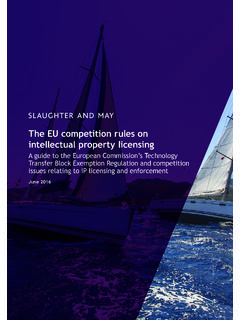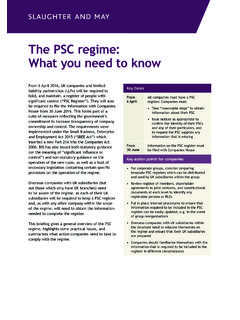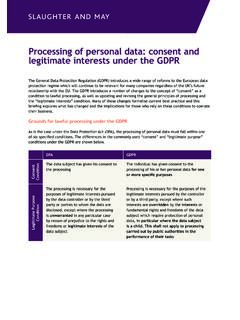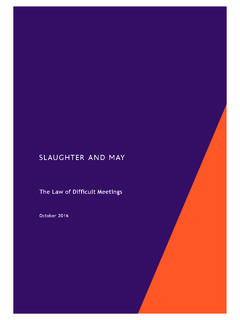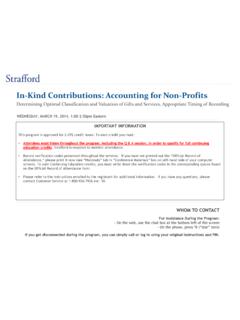Transcription of Due Diligence and Disclosure in Private Acquisitions and ...
1 Due Diligence and Disclosure in Private Acquisitions and Disposals slaughter and may August 2007. contents 1. introduction 1. 2. putting due Diligence and Disclosure into context 2. 3. due Diligence 6. What is due Diligence ? 6. Why do due Diligence ? 6. Who does due Diligence ? 7. The due Diligence questionnaire 8. Gathering and analysing due Diligence material 9. Data rooms 12. Actual knowledge and due Diligence 13. 4. Disclosure 15. What is a Disclosure letter? 15. What is the function of a Disclosure letter? 15. What does a Disclosure letter look like?
2 15. General disclosures 15. Speci c disclosures 16. Timing issues 17. Actual knowledge and Disclosure 18. Data rooms and Disclosure 19. diagram 1 - When due Diligence and Disclosure are done 5. diagram 2 - The due Diligence questionnaire - areas commonly addressed 10. slaughter and may 1. introduction This guide is a summary of what to expect when involved in the due Diligence or Disclosure process in the context of Private Acquisitions and disposals. It can be used by those on the acquisition team who are responsible for negotiating the terms of the deal as well as the managers of the target business who will be responsible for gathering together the due Diligence material and making disclosures .
3 It aims to cover issues of concern to both sellers and purchasers. The due Diligence exercise is an important element of any acquisition. It is the means by which a purchaser veri es the deal it has struck. Done properly, doing due Diligence may help to prevent the purchaser from doing a bad deal. However, what it involves is not precisely de ned. Furthermore, as this guide will explain, it is not a process entirely without drawbacks. Parting with due Diligence information helps the seller limit its potential liability to the purchaser.
4 It also draws together the information needed to prepare the seller's Disclosure letter. The seller will need to consider whether disclosing documents poses a problem because, for example, they are subject to third party con dentiality restrictions or legally privileged. Although traditionally purchaser led, due Diligence is increasingly seller initiated as auction sales and data rooms become more popular. Regardless of who initiates the process, the due Diligence teams on both sides often comprise a large number of individuals.
5 Not only the parties' own personnel, but also their legal and nancial advisers, accountants and various specialists are commonly involved. This makes clear demarcation of responsibilities, lines of communication and reporting procedures essential. What follows should give a avour of why this is so important. Having worked hard on due Diligence , the parties' teams have often run out of steam by the time it comes to dealing with the Disclosure letter. This guide seeks to explain why it is important that both parties understand the role of the Disclosure letter and appreciate the signi cance of the Disclosure exercise.
6 1 slaughter and may 2. putting due Diligence and Disclosure into context Private Acquisitions and disposals This guide deals with due Diligence and Disclosure in the context of the sale or purchase of shares in unlisted companies or businesses. Before considering in a little more detail what due Diligence and Disclosure actually are and why they are done, let's start by putting them into context. When are they done and what else does an acquisition involve? Basic stages The following is a very simpli ed cascade of events: Traditional bilateral sale Auction sale > Striking the basic deal (and sometimes > Information gathering and planning recording it in heads of agreement).
7 (including despatching information memorandum and setting up data room). > Information gathering and planning. > Seller drafts the principal documentation. > Purchaser due Diligence . > Data room opens to selected rst round bidders. > Drafting the principal documentation. > Indicative offers by rst round bidders. > Second round bidders short listed. > Second round bidders continue due Diligence and submit nal offers (including mark up of principal documentation). > Striking the basic deal with preferred bidder (and sometimes granting exclusivity).
8 > Negotiating the principal documentation. > Exchanging the acquisition agreement (often referred to as signing ). > If the acquisition is conditional, dealing with the conditions (for example, seeking shareholder approval or various merger, regulatory or industry consents). > Completing (often referred to as closing ) immediately after exchange, if there are no conditions, or, if there are, a few days after those conditions have been satis ed. > Dealing with post-completion matters. 2 slaughter and may The role of due Diligence For the purchaser, due Diligence forms the major part of the information gathering and planning stage.
9 It involves gathering the information which enables the planning to take place. The purchaser uses the due Diligence information to evaluate the business it wants to buy. For the seller, due Diligence facilitates its Disclosure exercise. Its Disclosure of information as part of the due Diligence process helps to limit its potential liability to the purchaser and draws together the information needed to prepare its Disclosure letter. The role of warranties and the Disclosure letter Traditionally, it was the warranties set out in a schedule to the acquisition agreement which ushed out information about the target business.
10 Warranties are statements about the company or business (given at exchange and often repeated at completion if there is a gap between the two) which give the purchaser the basis of a claim for damages if they prove to be incorrect and the purchaser suffers loss as a consequence. The warranty schedule, comprising a large number of speci c, often repetitive, statements about the target business, was information seeking. One of its major roles was to identify areas of concern to the purchaser. The seller then used the warranty schedule as a checklist for giving information to the purchaser in its Disclosure letter.





